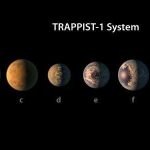NASA’s incredible exoplanet-hunting telescope is about to launch0
- From Around the Web, Space
- April 16, 2018
TESS will give us a new view of our galactic neighborhood.

TESS will give us a new view of our galactic neighborhood.

Astronomers using data from NASA’s extended Kepler mission, known as K2, have discovered 95 new exoplanets, with sizes ranging from mostly rocky super-Earths and fluffy mini-Neptunes to Jupiter-like gaseous giants.

Two exoplanets in the TRAPPIST-1 system have been identified as most likely to be habitable, a paper by PSI Senior Scientist Amy Barr says.

In NASA’s efforts to explore the endless expanse of space, the agency eventually came to a realization: there is simply too much data. Missions like the one embarked upon in 2009 by the Kepler space telescope yield such a tremendous amount of data that there’s no efficient way for an individual scientist or even a team of scientists at NASA to pour through it all. That’s when they made a realization — instead of handling everything internally, NASA could make this data publicly available so that citizen scientists all over the world would be able to dig in.

Astronomers have discovered that the well-studied exoplanet WASP-12b reflects almost no light, making it appear essentially pitch black.

Worlds with a permanent day and night side aren’t obvious places to look in the search for extraterrestrial life. Apart from having extremes of temperature, such planets would make it hard for a biological clock to get going.

Since the mid-1990s, when the first planet around another sun-like star was discovered, astronomers have been amassing what is now a large collection of exoplanets—nearly 3,500 have been confirmed so far.

After NASA announced in February the discovery of a solar system with seven planets—three of which were deemed potentially habitable—UChicago postdoctoral scholar Sebastiaan Krijt began wondering: If a life form existed on one of these planets, could space debris carry it to another?

Ever since enthusiasm started growing over the possibility that there could be a ninth major planet orbiting the sun beyond Neptune, astronomers have been busy hunting it.

Life on an alien planet with two suns in its sky, like Luke Skywalker’s home world Tatooine in the “Star Wars” films, may indeed be possible, a new study suggests.



